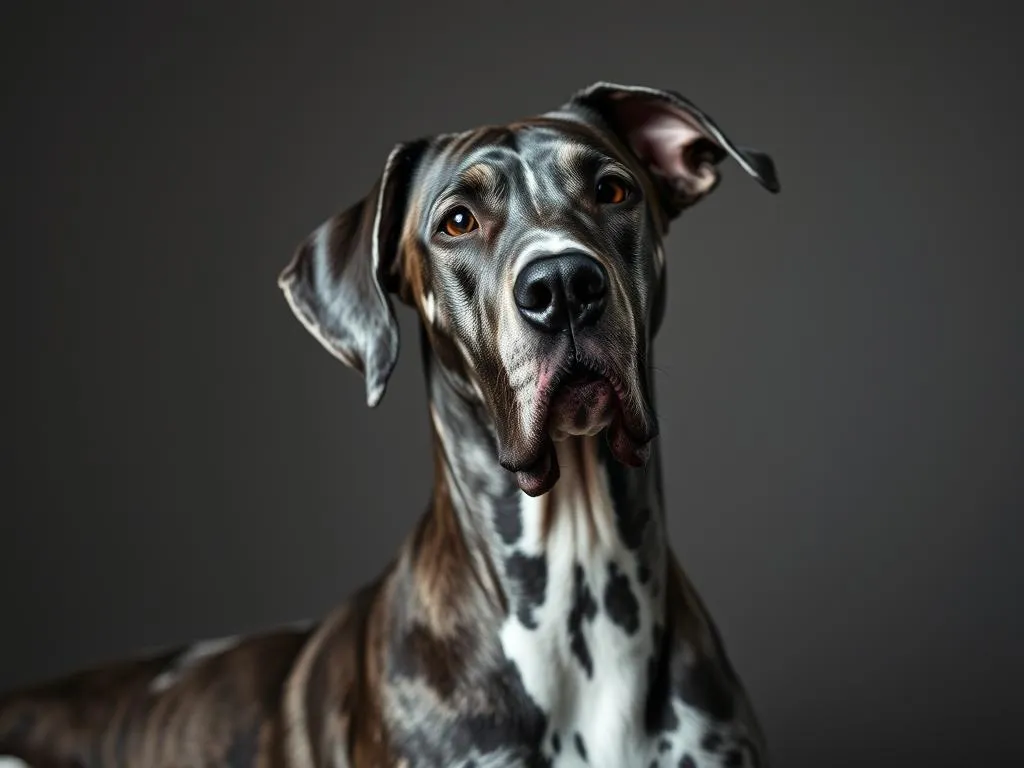
Understanding dog breeds is essential for potential pet owners, especially when considering the great dane lifespan—how long do they live? The Great Dane is a magnificent breed, known for its size and gentle nature. This article delves into the history, characteristics, lifespan, care, and how to enhance the life of these gentle giants.
Understanding the Great Dane
Origin and History
The Great Dane, often heralded as the “Apollo of dogs,” has a rich and storied history. This breed’s origins trace back to ancient times, with connections to the Mastiff family. Great Danes were initially bred in Germany for hunting large game, such as wild boar. Their impressive stature and strength were essential for these tasks, showcasing their capability as both hunters and guardians.
Over the centuries, Great Danes transitioned from noble hunters to beloved companions. Their gentle disposition and loyalty have made them a popular choice among families, earning a special place in many households across the globe.
Physical Characteristics
Great Danes are known for their impressive size. Adult males typically weigh between 140-175 pounds, while females range from 110-145 pounds. Their height can vary, with males standing 30-34 inches tall at the shoulder and females measuring 28-32 inches.
In terms of coat colors and patterns, Great Danes come in various shades, including:
- Fawn
- Brindle
- Blue
- Black
- Harlequin (white with irregular black patches)
- Mantle (black with a white patch on the chest)
Distinctive features of the Great Dane include their long, powerful legs and expressive, large eyes. Their ears can either be cropped or left natural, adding to their regal appearance.
Temperament and Behavior
The temperament of Great Danes is one of their most endearing qualities. They are known for being friendly, loyal, and affectionate. Despite their enormous size, they are often referred to as “gentle giants” due to their calm demeanor.
Common behavioral traits include:
- Playfulness: Great Danes enjoy playtime and are often very animated, especially as puppies.
- Need for companionship: They thrive on human interaction and can become anxious if left alone for long periods.
Lifespan of Great Danes
Average Lifespan
The great dane lifespan typically ranges from 7 to 10 years, which is relatively short compared to other dog breeds. Many factors influence this lifespan, including genetics, health care, and lifestyle. When compared to smaller breeds, which can live into their teens, the Great Dane’s shorter lifespan is notable and requires attention from potential owners.
Factors Influencing Lifespan
Several factors can greatly influence how long Great Danes live:
-
Genetics and Hereditary Conditions: Like many breeds, Great Danes can be prone to certain genetic health issues, including hip dysplasia and heart conditions, which can shorten their lifespan.
-
Environmental Factors: Living conditions play a crucial role in a dog’s health. Great Danes that live in a stable, loving environment generally thrive better than those in stressful situations.
-
Nutrition and Diet Impact: A well-balanced diet can significantly influence a Great Dane’s overall health and longevity. Proper nutrition is vital for maintaining a healthy weight and reducing the risk of obesity-related issues.
Common Health Issues
Great Danes are susceptible to a few breed-specific health problems, including:
-
Dilated Cardiomyopathy (DCM): A serious heart condition that is common in large breeds, including Great Danes.
-
Hip Dysplasia: A genetic condition that affects the hip joint, leading to arthritis and pain.
-
Bloat: A life-threatening condition where the stomach fills with gas and twists. Great Danes are particularly prone to this, and immediate veterinary attention is crucial.
Regular veterinary care is essential to keep these health issues in check. Routine check-ups can help catch potential problems early, ensuring a better quality of life for your Great Dane.
Caring for Your Great Dane
Nutrition and Diet
Providing the right nutrition is critical for a Great Dane’s health. A high-quality diet that is specially formulated for large breeds is recommended. Key components to consider include:
- High protein content: Essential for muscle development and maintenance.
- Controlled calcium and phosphorus levels: Important for bone health and growth.
Portion control is crucial, as Great Danes can be prone to obesity, which puts added stress on their joints and heart. A regular feeding schedule is also recommended to maintain digestive health.
Exercise Needs
Despite their size, Great Danes do not require excessive amounts of exercise, but daily physical activity is essential. Suitable activities include:
- Leashed walks: Regular walks can help maintain a healthy weight and strengthen the bond between the dog and owner.
- Playtime: Engaging in games like fetch or tug-of-war can provide both physical and mental stimulation.
On average, Great Danes should get at least 30 to 60 minutes of exercise per day, spread throughout the day to avoid overexertion.
Regular Veterinary Care
Routine check-ups and vaccinations are vital for your Great Dane’s health. A good veterinary care plan might include:
- Annual health screenings: To check for common health issues, especially heart and joint conditions.
- Vaccinations: Keeping up with vaccinations is crucial for preventing diseases.
Preventative care can help detect and treat potential health problems early, ensuring your Great Dane lives a longer, healthier life.
Enhancing Your Great Dane’s Lifespan
Proper Training and Socialization
Training and socialization are crucial for a Great Dane’s development and well-being. Early training helps instill good manners and can prevent behavioral issues later in life. Socializing your Great Dane with other animals and people can also help them become well-adjusted adults.
Weight Management
Obesity poses significant risks for Great Danes, including joint issues and heart problems. To maintain a healthy weight, consider:
- Monitoring food intake: Keep track of portion sizes and avoid overfeeding.
- Regular exercise: Ensure your Great Dane gets adequate exercise to burn off excess calories.
Creating a Safe Living Environment
A safe home environment is essential for preventing injuries. Consider the following:
- Safe setup: Remove hazards such as small items that could be swallowed and secure potentially dangerous areas.
- Mental stimulation: Providing toys and engaging activities can keep your Great Dane mentally stimulated, reducing boredom and associated behavioral issues.
Conclusion
Understanding the great dane lifespan—how long do they live—is essential for potential owners. These dogs, while magnificent and loving, come with specific care requirements that must be met for them to thrive. By prioritizing proper nutrition, regular veterinary care, and a safe, stimulating environment, you can ensure a happy and healthy life for your Great Dane.
In embracing the responsibilities of dog ownership, you’re not just gaining a pet; you’re inviting a loyal companion into your life, one who will bring joy and unconditional love for as long as possible.









